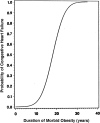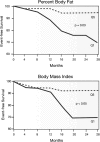Obesity and hypertension, heart failure, and coronary heart disease-risk factor, paradox, and recommendations for weight loss
- PMID: 21603427
- PMCID: PMC3096264
Obesity and hypertension, heart failure, and coronary heart disease-risk factor, paradox, and recommendations for weight loss
Abstract
Obesity prevalence has reached epidemic proportions and is independently associated with numerous cardiovascular disease (CVD) risk factors, including diabetes mellitus, hypertension, dyslipidemia, cancers, sleep apnea, and other major CVDs. Obesity has significant negative impact on CVD, including hypertension, coronary heart disease, heart failure, and arrhythmias via its maladaptive effects on individual CVD risk factors and cardiac structure and function. Despite this negative association between obesity and the incidence and prevalence of CVD, many studies have demonstrated that obese patients with established CVD might have better short- and long-term prognosis, suggesting an "obesity paradox." This intriguing phenomenon has been well documented in populations with heart failure, coronary heart disease, and hypertension. This review summarizes the adverse effects of obesity on individual CVD risk factors; its role in the genesis of CVDs, including heart failure, coronary heart disease, and hypertension; and the obesity paradox observed in these populations and the potential underlying mechanisms behind this puzzling phenomenon and concludes with a discussion on the potential benefits of weight reduction.
Keywords: Coronary heart disease; heart failure; hypertension; obesity; obesity paradox; weight loss.
Figures





References
-
- Poirier P., Giles T. D., Bray G. A., et al. Obesity and cardiovascular disease: pathophysiology, evaluation, and effect of weight loss: an update of the 1997 American Heart Association Scientific Statement on Obesity and Heart Disease from the Obesity Committee of the Council on Nutrition, Physical activity, and Metabolism. Circulation. 2006;113:898–918. - PubMed
-
- Artham S. M., Lavie C. J., Milani R. V., Ventura H. O. The obesity paradox: impact of obesity on the prevalence and prognosis of cardiovascular diseases. Postgrad Med. 2008;120:34–41. - PubMed
-
- Klein S., Burke L. E., Bray G. A., et al. Clinical implications of obesity with specific focus on cardiovascular disease: a statement for professionals from the American Heart Association Council on Nutrition, Physical Activity, and Metabolism: endorsed by the American College of Cardiology Foundation. Circulation. 2004;110:2952–2967. - PubMed
-
- Flegal K. M., Carroll M. D., Ogden C. L., Johnson C. L. Prevalence and trends in obesity among US adults, 1999-2000. JAMA. 2002;288:1723–1727. - PubMed
-
- Lavie C. J., Milani R. V., Ventura H. O. Obesity and cardiovascular disease: risk factor, paradox, and impact of weight loss. J Am Coll Cardiol. 2009;53:1925–1932. - PubMed
LinkOut - more resources
Full Text Sources
Other Literature Sources
